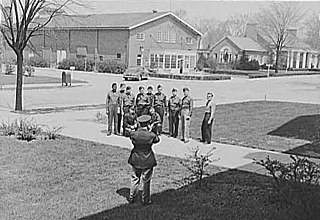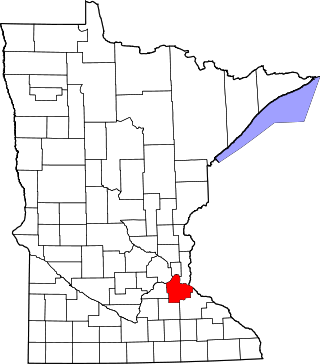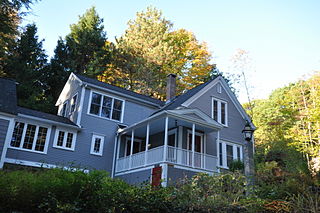
The Financial District of Lower Manhattan, also known as FiDi, is a neighborhood located on the southern tip of Manhattan in New York City. It is bounded by the West Side Highway on the west, Chambers Street and City Hall Park on the north, Brooklyn Bridge on the northeast, the East River to the southeast, and South Ferry and the Battery on the south.

Fort Wood Historic District is a historic neighborhood in Chattanooga, Tennessee. It is bounded roughly by Palmetto Street, McCallie Avenue, East 4th Street, and O'Neal Street, just east of the campus of the University of Tennessee at Chattanooga.

Fort Benjamin Harrison was a U.S. Army post located in suburban Lawrence Township, Marion County, Indiana, northeast of Indianapolis, between 1906 and 1991. It is named for the 23rd United States president, Benjamin Harrison.

The Lummus Park Historic District or simply Lummus Park, is on the National Register of Historic Places and a locally historic designated district in Miami, Florida. It is roughly bound by Northwest Fifth Street to the north, Flagler Street to the south, Northwest Third Avenue to the east, and the Miami River to the west. On October 25, 2006, it was added to the U.S. National Register of Historic Places. Lummus Park has some of the oldest structures in Miami, and over the decades, has been able to retain a large part of its early pioneer character.

The Minne Lusa Residential Historic District is located in North Omaha, Nebraska. It is included on the National Register of Historic Places. According to the National Park Service, it is an "example of a substantial, affordable single-family residential development within the city limits that was platted, developed and constructed by a single firm between 1915 and 1941." The neighborhood is filled with bungalows, Craftsman, and other styles that were popular in the era. There are 540 properties in the neighborhood that contribute to the historic district, the other 167 do not. Minne Lusa Boulevard is a contributing structure.

This is a list of the National Register of Historic Places listings in Dakota County, Minnesota. It is intended to be a complete list of the properties and districts on the National Register of Historic Places in Dakota County, Minnesota, United States. Dakota County is located in the southeastern part of the U.S. state of Minnesota, bounded on the northeast side by the Upper Mississippi River and on the northwest by the Minnesota River. The locations of National Register properties and districts for which the latitude and longitude coordinates are included below, may be seen in an online map.

This list is of the properties and historic districts which are designated on the National Register of Historic Places or that were formerly so designated, in Hennepin County, Minnesota; there are 190 entries as of April 2023. A significant number of these properties are a result of the establishment of Fort Snelling, the development of water power at Saint Anthony Falls, and the thriving city of Minneapolis that developed around the falls. Many historic sites outside the Minneapolis city limits are associated with pioneers who established missions, farms, and schools in areas that are now suburbs in that metropolitan area.

This is a list of the National Register of Historic Places listings in Goodhue County, Minnesota. It is intended to be a complete list of the properties and districts on the National Register of Historic Places in Goodhue County, Minnesota, United States. The locations of National Register properties and districts for which the latitude and longitude coordinates are included below, may be seen in an online map.

There are 75 properties listed on the National Register of Historic Places in Albany, New York, United States. Six are additionally designated as National Historic Landmarks (NHLs), the most of any city in the state after New York City. Another 14 are historic districts, for which 20 of the listings are also contributing properties. Two properties, both buildings, that had been listed in the past but have since been demolished have been delisted; one building that is also no longer extant remains listed.

The W. B. Davis Hosiery Mill is a historic industrial complex in Fort Payne, Alabama. It opened in 1884 in the midst of Fort Payne's economic boom, manufacturing building hardware and supplies. The main building, which features Colonial Revival details, is three stories tall, with 12-over-12 sash windows on each floor. An 85-foot (26-meter) chimney has a flared top and corbeled brick course, imitating a doric order column. By 1890, hopes that large quantities of iron ore and other minerals would be discovered in the Fort Payne district proved to be ill-founded. The ABHMC and seven of Fort Payne's other large manufacturers merged in an effort to remain in business, but they were unable to avoid bankruptcy.

The Fort Payne Depot Museum is a historic building in Fort Payne, Alabama. The depot was built by the Alabama Great Southern Railroad in 1891, at the height of Fort Payne's mining-driven boom. Passenger service ended in 1970, but the depot continued to service freight until 1983. It was converted into a museum in 1986, which includes exhibits with 19th century and Native American artifacts, a collection of dioramas of fantasy scenes and historical events, and a former Norfolk Southern caboose. The depot was designed in Richardsonian Romanesque style by architect Charles C. Taylor. It is clad in grey sandstone with pink granite trim. The hipped roof has several gables protruding from it, as well as a circular tower on one corner. The depot was listed on the National Register of Historic Places in 1971.

The Fort Payne Boom Town Historic District is a historic district in Fort Payne, Alabama. The district encompasses five properties built around 1889, when Fort Payne was undergoing huge growth owing to the area's mineral deposits. Included are the Alabama Great Southern Depot; the Fort Payne Opera House; the Sawyer Building, a two-story Victorian commercial building; City Park, which sat across from the (now-demolished) county courthouse; and Purdy Furniture, which built as the headquarters of the Fort Payne Coal and Iron Company. Another Victorian commercial building has since been demolished. The district was listed on the National Register of Historic Places in 1989.

The Fort Payne Main Street Historic District is a historic district in Fort Payne, Alabama. Centered on the intersection of Gault Avenue and 1st Street, the district contains commercial and public buildings that date from Fort Payne's second period of growth from the 1920s to World War II. Buildings from the first wave of development in the 1880s and 1890s are centered in the Fort Payne Boom Town Historic District to the northeast. Most of the commercial buildings are in a simple, utilitarian brick style. The later civic buildings exhibit more decorated styles, including the Classical Revival Post Office, and the Art Moderne City Hall (1941) and DeKalb County Activities Building (1941). The district was listed on the National Register of Historic Places in 1989.

Dean Park Historic Residential District is a national historic district located at Fort Myers, Florida in Lee County. Its context is very similar to the one in the early 1920s, when the district was built.

The Shepard Hill Historic District encompasses an enclave of summer retreat properties in Holderness, New Hampshire. Centered on a stretch of Shepard Hill Road east of Holderness center, the area was one of the first to be developed as a summer estate area in the vicinity of Squam Lake, which Shepard Hill provided expansive views of. It includes 17 historic summer houses, built between 1870 and 1921, and a chapel. The district was listed on the National Register of Historic Places in 2014.

Fort Hill is a 0.4 square mile neighborhood and historic district of Roxbury, in Boston, Massachusetts. The approximate boundaries of Fort Hill are Malcolm X Boulevard on the north, Washington Street on the southeast, and Columbus Avenue on the southwest.

North Anthony Boulevard Historic District is a national historic district located at Fort Wayne, Indiana. The district encompasses 296 contributing buildings in a predominantly residential section of Fort Wayne, extending along North Anthony Boulevard from Lake Avenue in the south to Vance Avenue in the north. An overlapping designation includes all of the rights of way in the district, plus those on the rest of North Anthony south to the Maumee River, as well as on South Anthony Boulevard south of the river.

The Park-to-Park Residential Historic District in Fort Madison, Iowa, United States, was listed on the National Register of Historic Places in 2014. The historic district is located to the north of the Downtown Commercial Historic District, generally between Central Park on the west and Old Settler's Park on the east. Both parks are contributing sites. For the most part the district is made up of single family homes built in the late 19th and early 20th centuries. Some of these homes were built as rental properties, while others became so in later years. The Albright House and the Chief Justice Joseph M. Beck House are contributing properties, and they are also individually listed on the National Register. There are also duplexes and a few small scale apartment buildings in the district.






















